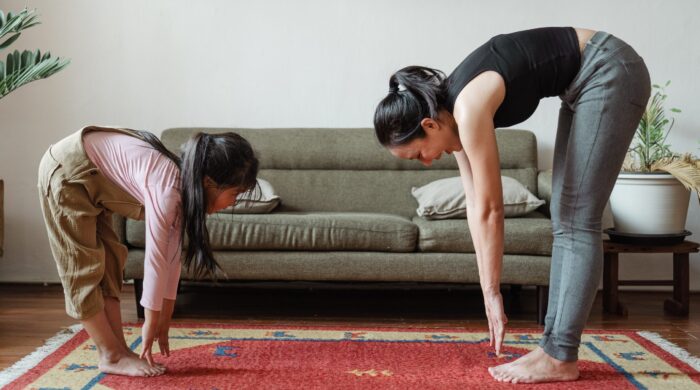For folks who spend more time at home indoors during the colder months, it’s important not to neglect your health – which means staying physically fit to the best of your ability.
In this post, we’ll cover the benefits of exercising at home, provide guidance on back and cardio exercises that can be safely done at home, and where to get support from a medical professional if you want help designing a personalized exercise plan.
Benefits of working out at home
Your quality of life can be negatively impacted by long periods of sedentary behavior. As we learned from the pandemic, being confined to our homes and moving less can affect our physical and our mental health.
To counteract this, it’s vital to incorporate physical activities into your day and weekly routine. And it can provide a necessary boost to your immune system in uncertain or stressful times.
The World Health Organization recommends either 75 minutes of vigorous activity or 150 minutes of moderate activity per week, or a combination of both.
You don’t need any special equipment to create your own exercise routine, just the space and time to complete it. The best part is that an exercise program can be done in the comfort and convenience of your own home without spending any money.
Furthermore, there’s the added luxury of privacy, and avoiding the spread of germs that can happen at a gym or fitness club (if that’s a concern for you).
In addition, being physically active is especially good for your mental health. Strength training has been proven to lessen anxiety. Moderate-to-vigorous physical activity is linked to increases in self-esteem, improvements in sleep and concentration, and lower levels of depression.
So whether you want a gentle, moderate, or more intense home workout, any level can provide you with physical and mental health benefits.
Types of back exercises
Your back can be vulnerable to pain from sitting in one position for long periods of time, such as being at a desk all day. Whether you work a desk job or not, these exercises can help strengthen muscles and prevent back pain.
Half crunches
With your tailbone and low back on the mat at all times, lie with your knees bent and feet flat on the floor. Tighten your core, put your hands behind your head and raise your shoulders off the floor as you breath out.
Hold this position for a second, then slowly return your shoulders to the floor. Be sure not to do a full “sit-up” as this can actually put pressure on the discs in your spine. Repeat this exercise at least eight times.
Hamstring stretches
Bend one knee as you lie on your back. Loop a scarf or towel under the ball of your foot, then straighten your leg and slowly tug on the towel. Hold for at least 15 seconds, but no longer than 30.
This should stimulate a gentle stretch down the back of your leg. Repeat twice on each leg and add repetitions as your legs become more flexible, but be sure not to add them too soon.
Knee lifts
Lie on your back with knees bent and feet firmly on the floor. Bring one knee to your chest, while the other foot remains flat on the floor.
Keep your lower back pressed to the floor, and hold the pose for 15 to 30 seconds. Slowly lower your knee and repeat with the other leg. Repeat this 2 to 4 times for each leg.
Types of cardio exercises
Cardiovascular exercises are essential for good health, as they make your blood pump faster by increasing your heart rate.
This delivery of oxygen throughout your body helps protect your heart and lungs and can lower your risk of developing chronic disease. Try these exercises to get a regular dose of necessary cardio.
Crab walk
From a sitting position on the floor, bend your knees as your feet remain flat. Place your hands under your shoulders with fingers pointing toward your feet.
Next, lift your hips off the floor and walk backwards using your arms and legs, keeping your weight evenly distributed between hands and legs. Walk a comfortable distance, then turn around and return to your original spot.
Jumping Jacks
Stand tall with your legs together and arms resting at your sides. Bend your knees, then jump and spread your legs wider than your shoulders, lifting your arms above your head. Then jump back in to bring your legs together. Repeat 10 times until you build up to more repetitions.
Squat jumps
Begin standing with your feet shoulder width apart, with the feet turned slightly out. Bend your knees and slowly lower to a squat.
Next, swing your arms back and then as you swing them upward, jump at the same time. Land slowly back into your squat. Repeat 5 times until you build up to more repetitions.
Get guidance from a medical professional
Western Washington Medical Group’s family medicine team can help you develop a safe home exercise plan appropriate for your fitness level.
Request an appointment today with one of our knowledgeable providers, and get the support you need to stay healthy while working out at home.
